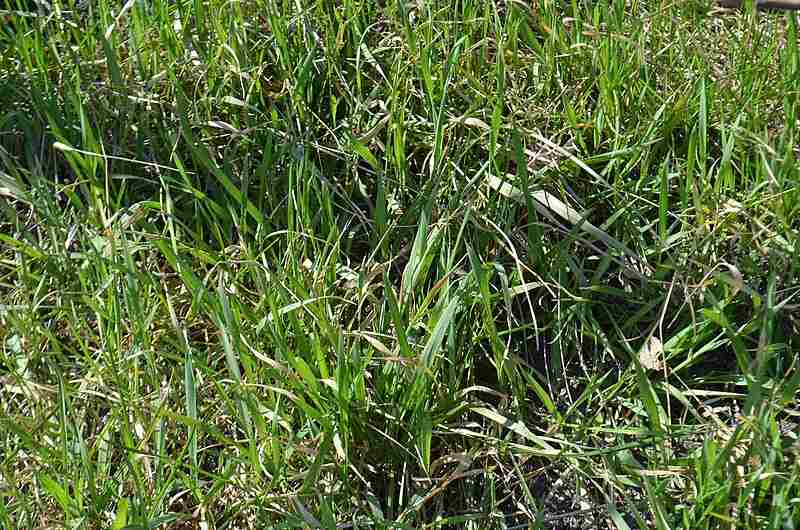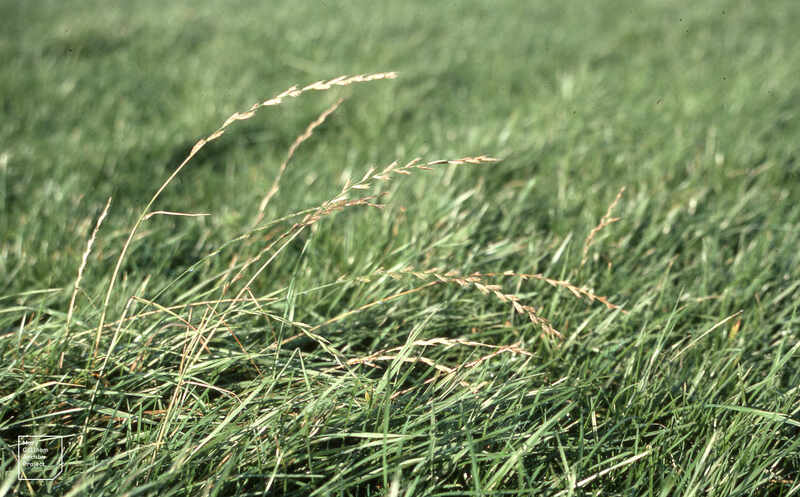
Zephyrs play through the trees, giving the Buckeye State its windy fame, and when Lake Erie freezes with cold, nature shows its full potential in Ohio. Not every turfgrass can successfully withstand this harsh weather, but don’t worry. In this article, we’ll explain the best grass seed for Ohio homeowners.
Cool-season turfgrasses are the best grass types for Ohio. They start to grow actively in the early fall and enter dormancy in the heat of the summer, when “the golden grain dwarf the lovely flowers” and residents can enjoy one of the state’s many swimming holes.
We’ll guide you through the best turfgrass seed options for your lawn, so you can have a yard that will survive the snowy weather as well as the humid summer heat. Your beautiful lawn will certainly be a view, just like the wonders of the land where your dreams all come true!
1. Kentucky Bluegrass

Ethan2039 | Wikimedia Commons | CC BY-SA 4.0
This high-quality cool-season grass was brought to the U.S. by European settlers and since then has been thriving statewide. With proper management, Kentucky bluegrass produces beautiful blueish-green foliage and a dense lawn.
Kentucky bluegrass (KBG) is considered a high-maintenance grass, requiring high levels of nitrogen and irrigation from early to late summer; otherwise, it’ll turn brown and go dormant. KBG is also prone to thatch. If you want a KBG lawn, be sure you’re willing to spend the time and resources to care for it. Beauty has its cost (or so they say)!
- Classification: Cool-season grass
- Spreads by: Rhizomes
- Shade tolerance: Low
- Drought tolerance: Moderate
- Foot traffic tolerance: Moderate
- Maintenance needs: Moderate mowing frequency and high fertilization needs.
- Mowing height: Set mowing height between 2.5 and 3.5 inches.
- Potential for disease: Moderate to high; prone to several diseases, such as dollar spot, leaf spot, necrotic ring spot, summer patch, and stripe smut.
- Soil pH: 6-7.5
- Soil type: Performs best in well-drained, heavy soils with high fertility.
- Other notes: KBG is commonly mixed with more shade-tolerant grass types (such as fine fescue) for lawns that receive both sun and shade.
Grass Seed Options:
– Jonathan Green (11970) Blue Panther Kentucky Bluegrass Grass Seed (3 lbs.)
– SeedRanch Midnight Kentucky Bluegrass Seed (5 lbs.)
– Jacklin Seed – Biltmore Blue Blend – 100% Kentucky Bluegrass (5 lbs.)
2. Perennial Ryegrass

Dr Mary Gillham Archive Project | Flickr | CC BY 2.0
Tolerant of both hot and cold temperatures, perennial ryegrass‘s adaptability is just one of its many practical qualities. The quick seed germination (four to seven days) and high foot traffic tolerance also make it a popular choice for homeowners. Additionally, this low-maintenance turfgrass won’t cause you many problems with weeds or thatch.
Although vulnerable to diseases like gray leaf spot, there are resistant cultivars on the market that will save you some headaches. Some even host beneficial fungi called endophytes, which help prevent bothersome lawn insects.
- Classification: Cool-season grass
- Spreads by: Has a bunch-type growth habit
- Shade tolerance: Low
- Drought tolerance: Low
- Foot traffic tolerance: High
- Maintenance needs: Moderate mowing and fertilization requirements. Thatch is not significant.
- Mowing height: Set mowing height to 1.5 to 2.5 inches
- Potential for disease: High. Common diseases include gray leaf spot, red thread, and leaf spot/melting-out.
- Soil pH: Can grow in soils with a pH between 5 and 8, but prefers between 6 and 7.
- Soil type: Prefers good drainage and fertility, but can tolerate some poor drainage.
- Other notes: Growing perennial ryegrass as a monostand is not recommended. For this reason, it is commonly mixed with Kentucky bluegrass seed.
Grass Seed Options:
– Outsidepride Perennial Ryegrass Seed (5 lbs.)
– Eretz ProTurf Perennial Ryegrass Fine Lawn Seed (choose your size)
3. Tall Fescue

Matt Lavin | Flickr | CC BY-SA 2.0
If you want to invest in a natural, organic lawn, turf-type tall fescue is your go-to. This grass is as low-maintenance as one can be. Turf-type tall fescue tolerates compacted soils and has a drought tolerance suitable to endure Ohio’s droughts with no need for irrigation. It has the best tolerance for both shade and sun among cool-season grasses and is also disease-resistant.
Recently improved varieties are perfect for a home lawn: They have a beautiful dark-green color and are less coarse in texture than the typical pasture-type tall fescue. Additionally, most turf-type tall fescues have endophytes to help kill common lawn insects.
- Classification: Cool-season grass
- Spreads by: Produces short rhizomes but has a bunch-type growth habit
- Shade tolerance: Moderate
- Drought tolerance: Moderate to High
- Foot traffic tolerance: Moderate
- Maintenance needs: Frequent mowing. Does not produce significant thatch.
- Mowing height: Set mowing height to 2 inches when the grass reaches 3 inches tall.
- Potential for disease: Tolerant of most diseases when properly maintained.
- Soil pH: 5.5-6.5
- Soil type: Adapted to a wide range of soil conditions, but prefers fertile clay soils with good drainage.
- Other notes: The Ohio State University suggests homeowners invest in turf-type cultivars rather than the “Kentucky 31” variety.
Grass Seed Options:
– Triple-Play Tall Fescue Grass Seed Blend (5000 sq ft)
– Eretz Kentucky 31 K31 Tall Fescue Grass Seed (choose your size)
– Pennington The Rebels Tall Fescue Grass Seed Mix (7 lb.)
4. Fine Fescue

Matt Lavin | Flickr | CC BY-SA 2.0
This grass type was the first choice for shade areas before tall fescues came around. The leaf blades are fine (as the name suggests) and the grass grows well in poor, acidic soil. Fine fescues are frequently mixed with Kentucky bluegrass in sun-shade lawns.
Fine fescue varieties include chewings fescue, red fescue, creeping fescue, hard fescue, and sheep fescue. Drought tolerance will vary depending on the species, but overall, fine fescues require low levels of nitrogen fertilizer and rarely have problems with thatch. Opt for cultivars with endophytes to help with insect control.
- Classification: Cool-season grass
- Spreads by: Creeping red fescue spreads by rhizomes, while other fine fescues are bunch-type grasses, such as Chewings, hard, and sheep fescues.
- Shade tolerance: Moderate to High, depending on species
- Drought tolerance: Moderate to High, depending on species
- Foot traffic tolerance: Low to Moderate, depending on species
- Maintenance needs: Low fertilizer and mowing needs
- Mowing height: Set mowing height between 2.5 and 4 inches, depending on species.
- Potential for disease: Moderate. Common diseases include red thread, leaf spot, dollar spot, summer patch, and powdery mildew.
- Soil pH: 6-6.5
- Soil type: Will not perform well in wet soil conditions. Prefers drier soils and tolerates a wide range of soil types and fertility.
- Other notes: With good shade tolerance, fine fescues are frequently used in a grass seed mix for lawns with partial shade. The fine fescue will eventually become the predominant grass in the shady areas of the lawn. Their low-maintenance needs are also a reason homeowners may opt for them.
Grass Seed Options:
– Outsidepride Legacy Fine Fescue Grass Seed (5 lbs.)
– Eretz Creeping Red Fine Fescue Seed (choose your size)
– Outsidepride Creeping Red Fine Fescue Grass Seed (25 lbs.)
How to Choose the Best Grass Seed for Ohio
Make sure you evaluate your yard before planting grass seed in Ohio. To help you make a decision on the best grass for your lawn, here are some criteria to consider before buying your grass seed:
Shade Tolerance
Take a look at your lawn. Is it exposed to full sun or does it have shady areas? Every grass needs sun to grow properly, but some are more shade-tolerant than others.
- High to moderate shade tolerance: Fine fescues and tall fescue
- Low shade tolerance: Kentucky bluegrass and perennial ryegrass
Irrigation Needs
Irrigation is also important to consider when choosing the best grass type for your Ohio lawn. If you have a sprinkler system, irrigation will certainly be an easier job, but the expenses on your water bill will increase. It’s important to note that except for tall fescue, cool-season grasses require some extra summer irrigation to keep their green color — otherwise, they’ll go dormant.
- High irrigation needs: Kentucky bluegrass
- Moderate irrigation needs: Perennial ryegrass
- Low irrigation needs: Tall fescue and fine fescue
Potential Problems
Another point to have in mind is if the turfgrass is prone to problems with insects and diseases.
- High to moderate vulnerability: Perennial ryegrass, Kentucky bluegrass, and fine fescue
- Low vulnerability: Tall fescue
Overall Maintenance Needs
To make it even easier for you, we ranked the grasses from the highest maintenance requirements to the lowest:
- 1. Kentucky bluegrass
- 2. Perennial ryegrass
- 3. Tall fescue
- 4. Fine fescue
Need a Helping Hand?
There are so many important aspects of picking the right grass seed for your new lawn: aesthetics, maintenance costs, and the practical care and effort it involves. If you are worried about making a rash decision and need help choosing the best grass type for you, we’ve got you covered!
We have the best Ohio lawn care pros near you! We have trusted lawn care pros in Columbus, Cleveland, Cincinnati, Toledo, Akron, and many more cities across the Buckeye State.
Lyrics are from Beautiful Ohio by MacDonald, Earl, and McBride
Main Image Credit: Blervis | Wikimedia Commons | CC BY-SA 4.0
Lawn Love participates in the Amazon Services LLC Associates Program, an affiliate advertising program. Lawn Love may earn revenue from products promoted in this article.